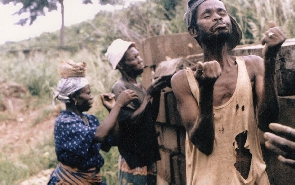 Adamorobe sign language/Photo credit: StoryMine
Adamorobe sign language/Photo credit: StoryMine
Adamorobe, a village in the West African nation of Ghana, is known as the ‘deaf community’ due to a high incidence of a hereditary form of deafness. However, in the wake of the mishap life placed on them, the community has found an innovative way to normalize their hereditary condition by developing their own sign language, which has been adopted by both the deaf and hearing people in the village. This is quite different from the formal standard sign language used in the school of the deaf.
This is not the only challenge the deaf inhabitants have fought against. In 1961, one of the chiefs instituted a law to prohibit marriage between deaf people in Adamorobe as a measure to reduce the number of deaf people. This law only succeeded in threatening the linguistic and cultural cord that preserved the social fiber of the community. The life of sign language hinges on the perception that deaf people are productive and significant members of society.
In recent times, urbanization has presented a new challenge to the survival of the people of Adamorobe. The increasing demand for stones to feed the construction industry has created a new business venture at the entrance of the village. Tonnes of stones are carted from Adamorobe from an open quarry, raising concerns that these outsiders will adulterate the culture of the deaf community. One of the treasured customs of the people is to take a break from working on the land on Thursdays to allow the earth goddess to rest; giving the people an opportunity to trade in foodstuffs harvested from the farms during that period.
The uniqueness of the deaf community, according to Stan Dery, a deaf education specialist, is the hereditary condition the people suffer from. One of the explanations for this predicament is the myth that the town used to be ruled by a spiritual deaf god who made the children of the community deaf if their parents offended him. This is explained in an unrhythmic manner the custodian of the deaf god dances when she is possessed.
A second legend has it that there is a stream on the outskirts of the town whose water is not meant for domestic purposes, and townfolks are not supposed to step in on certain days. Those who break this taboo end up giving birth to deaf children.
The third explanation was that the deafness in the community was a result of the handiwork of a handsome energetic deaf young man who came into the town. Every girl was interested in marrying him irrespective of his condition. This stranger is believed to have sowed a seed of deafness in the community, a spell that has run through generations of Adamorobe people.
The fourth and last legend is that the Adamorobe people had a war with a neighboring town. The people sought the assistance of the totems to enable them to win the war. After the strife, the animals refused to transform into their original state, and decided to manifest themselves as children born deaf.
In her paper, A Descriptive Analysis of Adamorobe Sign Language in Ghana, Victoria Anna Sophie Nyst, explained that research carried out by Sir Alexander Drummond in 1961 revealed that the cause for the inhabitation of the community by deaf people is its magnetic nature which continuously attracts the same like-minded people. A follow-up medical survey carried out showed that the deafness in the community is genetic, rather than the migration of deaf people to Adamorobe.
To survive their condition, they came up with the Adamorobe Sign language, which is interspersed with the local Akan language – with sign language to enable both the deaf and hearing people to interact smoothly. One of the intriguing features of this unique language is how hearing people also have a good command of sign language. Oral tradition indicates that the language was developed in the 18th century and is distinct from what is taught in schools for the deaf.